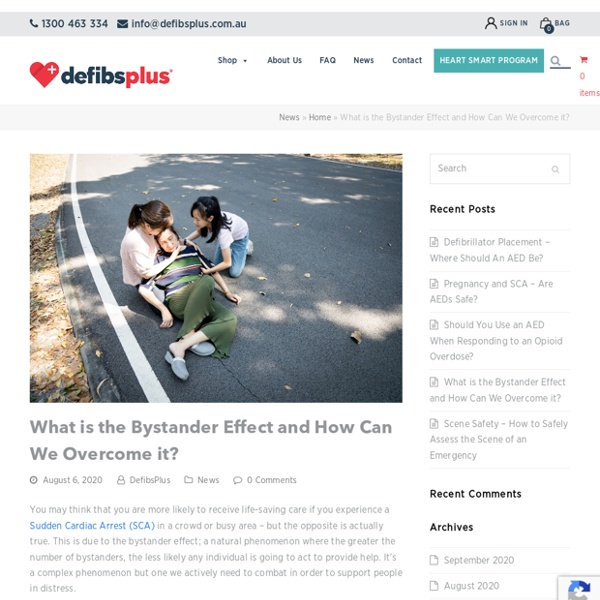Reducing the Bystander Effect
As discussed, there are a number of factors that magnify the Bystander Effect. Fortunately, there are also a number of factors that weaken it. Once again, factors can be divided into characteristics of the situation, and of the people. Situational characteristics Dangers of the incident The perceived danger of intervening in a critical situation has the greatest influence in reducing the Bystander Effect.
5 Effective Tips to Overcome the Bystander Effect
Do you know about the bystander effect? It's a social dynamic that affects almost everyone when an observed conflict is either ignored or worse, reinforced by the failure to act by those observing. An example of this would be a number of people in a park observing a man trying to take a woman's purse, yet doing nothing to report the crime or to deter the criminal by drawing attention to their actions. The sad fact is that most of us are vulnerable to this condition of non-action; but fortunately, there are things you can do to negate or minimize the impact. Here are a few tips for overcoming the bystander effect.
Get to Know the Differences Between Infant, Child and Adult CPR
Although responding to a sudden cardiac arrest (SCA) in a child or adult requires the same combination of rapid CPR and defibrillation, the differences in physiology mean you have to apply CPR a bit differently. Here are some tips from providers of CPR defibrillators and the Heart Smart Program, a leading CPR and defibrillator training program. How to Perform CPR on an Adult Place the heel of your hand with your palms down on the centre of the person’s chest. Place your other hand on top, interlocking your fingers.
Helping Kids Overcome the Bystander Effect
Newscasters love to share stories of kids as young as three years old calling 911 to save a parent’s life. These stories bear out what research has shown us: Very young children have a propensity to be kind and helpful. Starting as early as 18 months, studies show, toddlers spontaneously help an adult who is unable to pick up something he dropped or finds himself in a similarly tricky situation. Being kind at a cost to themselves makes two year olds happy, and three year olds who cooperate on a task share rewards even when they don’t have to. But a recent study suggests that, like adults, kids are also subject to a major obstacle to helping: the bystander effect. That’s when being part of a group paralyzes people from coming to the aid of someone in need—a phenomenon well documented by social psychologists.
How to Break the Bystander Effect
They could have left it to someone else. An Army veteran blocked a shooter in Oregon from entering his classroom. Three friends on a high-speed train from Paris to Amsterdam helped stop a gunman wielding an AK-47. This past spring, an Army captain in North Carolina pulled a couple to safety after a fiery car crash. Were these men instinctively courageous, or had they learned to be? The Army captain (aptly wearing a Captain America T-shirt) credited his military training for knowing what to do and remaining calm.
Anticipated Guilt for Not Helping and ...
Introduction Imagine that you hear that the blood-supplies are running low in all hospitals in your part of the country. You know that you could help by visiting the nearby donor clinic on your way back from work and donate blood (it would take you around 30 min).
How to Stay Heart Healthy Through the Summer – Defibs Plus Blog
Summer is a time for relaxing, recharging and enjoying quality time with friends and family – but to have the best summer, you need to stay heart healthy too! Here are some tips from leading suppliers of AEDs and defibrillators in Australia (we can get you the best defibrillator prices in town!) Manage the Heat For babies, seniors and those with serious medical conditions, the heat of summer can put a lot of extra strain on your body and heart, leading to heatstroke, dehydration, sunburn, heart attacks, sudden cardiac arrest (SCA) and heat stress. Please remember to:
How the Social Context Influences Helping – Principles of Social Psychology – 1st International Edition
Review Bibb Latané and John Darley’s model of helping behavior and indicate the social psychological variables that influence each stage. Although emotional responses such as guilt, personal distress, and empathy are important determinants of altruism, it is the social situation itself—the people around us when we are deciding whether or not to help—that has perhaps the most important influence on whether and when we help. Consider the unusual case of the killing of 28-year-old Katherine “Kitty” Genovese in New York City at about 3:00 a.m. on March 13, 1964.
How to be kinder to strangers in Singapore, Opinion News
The Charities Aid Foundation recently released the World Giving Index 2017, which provides insight into the scope and nature of giving around the world. Based on data collected from the Gallup World Poll, the index, which polled 1,000 individuals in each representative country, revealed two surprising facts. Myanmar, Indonesia and Kenya turned out to be among the most charitable countries, even though they have a huge number of their populations living below the poverty line.



